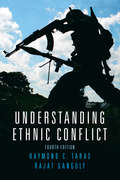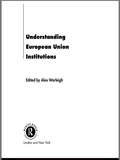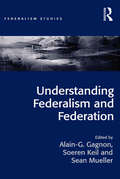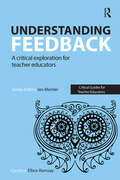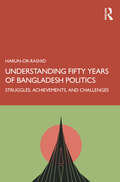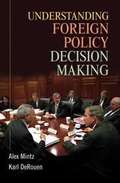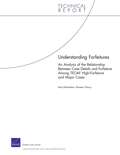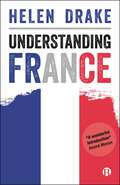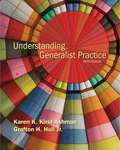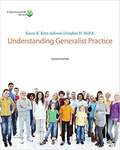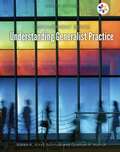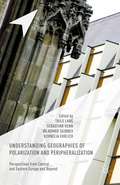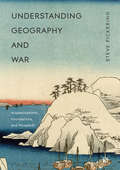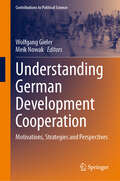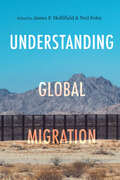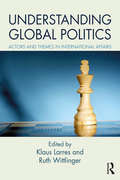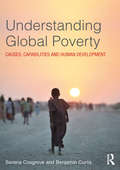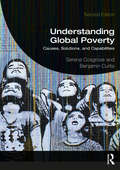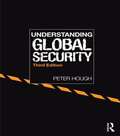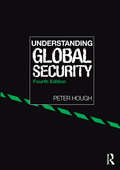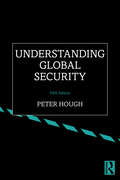- Table View
- List View
Understanding Ethnic Conflict
by Rajat Ganguly Raymond TarasUnderstanding Ethnic Conflict provides all the key concepts needed to understand conflict among ethnic groups. Including approaches from both comparative politics and international relations, this text offers a model of ethnic conflict's internationalization by showing how domestic and international actors influence a country's ethnic and sectarian divisions. Illustrating this model in five original case studies, the unique combination of theory and application in Understanding Ethnic Conflict facilitates more critical analysis of contemporary ethnic conflicts and the world's response to them.
Understanding European Union Institutions
by Alex WarleighUnderstanding the institutions of the European Union is vital to understanding how it functions. This book provides students with a user-friendly introduction to the main institutions, and explains their different roles in the functioning and development of the European Union.Key features:* introduces and explains the functions of all the main institutions dividing them into those that have a policy-making role, those that oversee and regulate, and those that operate in an advisory capacity* provides students with an overview of the history of the European Union and the development of its institutions and considers their continuing importance to the success of the European Union* clearly written by experienced and knowledgeable teachers of the subject* presented in a student friendly format, providing boxed concepts and summaries, guides to further reading, figures and flowcharts, and a glossary of terms.
Understanding Federalism and Federation (Federalism Studies)
by Alain-G. Gagnon Soeren KeilBased on a variety of contemporary debates on federal theory Understanding Federalism and Federation honours Michael Burgess’ contribution to the study of these topics through a selection of approaches, theories, debates and interpretations. Gathering contributors from diverse subfields to synthesize current debates it offers a snapshot of the immense range of current research on federalism and federation. Leading authors debate key issues such as American federalism, Canada and the role of Quebec, the latest insights into comparative federalism and federation, the European Union as a federal project and the analysis of constitutional courts in federal systems. Different theoretical and empirical fields and perspectives are brought together, synthesizing major findings and addressing emerging issues and these topics are analysed through multiple lenses to provide new insights, original approaches and much-needed theoretical and empirical data on federalism and federation.
Understanding Feedback: A critical exploration for teacher educators (Critical Guides for Teacher Educators)
by Caroline Elbra-RamsayA critical text on feedback and assessment for all teacher educators. Feedback can be key to learning, but its potential value is not always fulfilled in practice. Developing a more nuanced understanding of feedback is particularly crucial in the ITE sector where ITE students receive feedback as learners but also give feedback to their pupils, and teacher educators need to provide feedback to their students and also guide them to give effective feedback to their pupils.This book explores what feedback means in the ITE sector and more broadly within education. It discusses the relational, pedagogical and moral dimensions of feedback conceptualized by student teachers, drawing on research data and supporting teacher educators considering the implications for their own practice. It includes discussion of placement and academic assessment / feedback practice as well as referencing the Teachers’ Standards, the Core Framework for ITT and recommendations from the Carter Review.
Understanding Fifty Years of Bangladesh Politics: Struggles, Achievements, and Challenges
by Harun- Or-RashidThis book studies the first 50 years of Bangladesh politics since independence. It looks at Bangladesh politics as a unique case for study to analyze and understand the role of institutions, political parties, the election commission, election-time government, judiciary, the media, etc. The volume cross-examines the 1971 War of Liberation and the brutal killing of the republic’s founding father in 1975 as the two great divides that crystallized in the political arena between the Awami League on the one side and the BNP and Jamaat-e-Islami on the other. Through deep dives on major historical events and key political developments that have since shaped Bangladesh’s entire society and politics, it then delves into topics including the parliament, electoral integrity, civil society, and politics as they take on a confrontational course.An incisive study on major struggles, achievements, and challenges faced by Bangladesh in the 20th century, this volume will be of great interest to scholars and researchers in political science, democracy, modern history, and South Asia studies.
Understanding Foreign Policy Decision Making
by Alex Mintz Karl Derouen Jr.Understanding Foreign Policy Decision Making presents a psychological approach to foreign policy decision making. This approach focuses on the decision process, dynamics, and outcome. The book includes a wealth of extended real-world case studies and examples that are woven into the text. The cases and examples, which are written in an accessible style, include decisions made by leaders of the United States, Israel, New Zealand, Cuba, Iceland, United Kingdom, and others. In addition to coverage of the rational model of decision making, levels of analysis of foreign policy decision making, and types of decisions, the book includes extensive material on alternatives to the rational choice model, the marketing and framing of decisions, cognitive biases, and domestic, cultural, and international influences on decision making in international affairs. Existing textbooks do not present such an approach to foreign policy decision making, international relations, American foreign policy, and comparative foreign policy.
Understanding Forfeitures
by Noreen Clancy Amy RichardsonThe Treasury Executive Office for Asset Forfeiture (TEOAF) administers the Treasury Forfeiture Fund (TFF), which receives deposits of nontax forfeitures made by current and former Treasury agencies. Participating agencies use TFF funds to disrupt and dismantle criminal enterprises. This report examines the relationship between targeted funding support of major financial investigations and the forfeiture outcomes of such investigations.
Understanding France
by Helen DrakeThis concise yet comprehensive volume gives a compelling introduction to the politics, society, economy and culture of France. Moving beyond popular stereotypes, the book explores the reality of a diverse and changeable France. It examines the significance of developments from #MeToo to the 2024 Paris Olympics, while placing France in its international context and assessing its response to global crises. The book provides: • an accessible, jargon-free account informed by the latest data; • an up-to-date analysis of today’s political landscape; • an ideal introduction for students and general readers alike. Building on the success of its predecessor volume Contemporary France, this is a highly authoritative text that offers its readers keys for understanding how France is facing the challenges and opportunities of today’s world.
Understanding General Deterrence
by Stephen L. QuackenbushThis book bridges the divide between formal and quantitative studies of deterrence by empirically testing and extending perfect deterrence theory. The author focuses on general deterrence, which relates to managing relations between states at all times, not only during crises.
Understanding Generalist Practice (5th edition)
by Karen K. Kirst-Ashman Grafton H. HullNew edition of a text that provides a framework for social work students to view the world from a generalist perspective. Emphasizing a core of micro-skills, Kirst-Ashman (U. of Wisconsin-Whitewater) and Hull (U. of Utah) present 16 chapters that discuss relationship-building, interviewing, and problem-solving abilities necessary for working with individual clients. They also orient students to think not only in terms of individual needs but also of group and community needs. New focus points include cultural competency, empowerment of people with disabilities, interviewing children in the context of abuse, updated information on substance abuse, and confidentiality with respect to electronic record-keeping. Annotation c. Book News, Inc., Portland, OR (booknews.com)
Understanding Generalist Practice (Brooks/Cole Empowerment Series)
by Karen K. Kirst-Ashman Grafton H. Hull Jr.Organized around the authors' coherent and cohesive Generalist Intervention Model, this introductory guide to generalist social work practice gives students the knowledge and skills they need to work with individuals and families, as well as the foundation to work with groups, communities, and organizations. <p><p> Updated to reflect current topics and practice, the book focuses on micro levels of social work practice while also discussing the interrelationship between the micro, mezzo, and macro levels. Part of the BROOKS/COLE EMPOWERMENT SERIES, UNDERSTANDING GENERALIST PRACTICE, 7th Edition, clearly identifies content related to the latest Council on Social Work Education (CSWE) Educational Policy and Accreditation Standards (EPAS) with icons throughout the text. <p><p> New learning objectives, which are correlated to chapter headings and summaries, guide students' reading and reinforce their understanding.
Understanding Generalist Practice (Mindtap Course List Series)
by Karen K. Kirst-Ashman Grafton H. HullOrganized around the coherent and cohesive Generalist Intervention Model, this guide to generalist social work practice incorporates the knowledge, skills, and professional values you need to work with individuals and families, as well as the foundation to work with groups, communities, and organizations. Updated to reflect current topics and practice, the book focuses on micro levels of social work practice while also discussing the interrelationship among the micro, mezzo, and macro levels. Part of the Brooks/Cole Empowerment Series, UNDERSTANDING GENERALIST PRACTICE, 8th Edition, clearly identifies content related to the latest Council on Social Work Education (CSWE) Educational Policy and Accreditation Standards (EPAS) with icons throughout the text. Learning objectives, which are correlated to chapter headings and summaries, guide your reading and reinforce your understanding.
Understanding Generalist Practice (Sixth Edition)
by Karen K. Kirst-Ashman Grafton H. Hull Jr.Organized around the authors' coherent and cohesive Generalist Intervention Model, this introductory guide to generalist social work practice provides users with the knowledge and skills they will need to work with individuals and families, as well as the foundation to work with groups, communities, and organizations. It explores the links between micro, mezzo, and macro levels of social work practice and reflects the latest EPAS standards with empowerment and strengths perspectives for partnering with clients.
Understanding Geographies of Polarization and Peripheralization: Perspectives from Central and Eastern Europe and Beyond (New Geographies of Europe)
by Thilo Lang Sebastian Henn Wladimir Sgibnev Kornelia EhrlichThis book presents a multifaceted perspective on regional development and corresponding processes of adaptation and response, focusing on the concepts of polarization and peripheralization. It discusses theoretical and empirical foundations and presents several compelling case studies from Central and Eastern Europe and beyond.
Understanding Geography and War
by Steve PickeringBy delving into the history of geopolitics and bringing us up to date with cutting-edge case studies looking at infrastructure, terrain, and maps, this book will dispel simplistic and misleading notions about the nature of how humans interact with the environment. Stops on the way will include critical geopolitics, religious geopolitics, popular geopolitics, feminist geopolitics, and, newest of all, critical quantitative geopolitics. More importantly, it uncovers new areas of research for the next generation of researchers, showing how critical and quantitative methods can be applied to look at how geography and war relate to diverse areas such as disease, sport, dispossession, and immigration.
Understanding German Development Cooperation: Motivations, Strategies and Perspectives (Contributions to Political Science)
by Wolfgang Gieler Meik NowakThis book outlines the history of German development policy, provides important insights into Germany's motivations for development aid and closes an important research gap in this field. From its beginnings to the present day, German development cooperation has undergone various political and institutional changes. This volume offers a comprehensive analysis of these phases and highlights the milestones that have shaped Germany's approach to international development. It is aimed at academics, students, political decision-makers and anyone seeking an in-depth understanding of the developments and challenges of German development policy.
Understanding Global Conflict and Cooperation: An Introduction to Theory and History (Ninth Edition)
by Joseph S. Nye David A. WelchA concise and penetrating introduction to world politics in an era of complex interdependence, this book aims to introduce students to the complexities of international politics by giving them a good grounding in traditional realist theory before turning to liberal and constructivist approaches that have become more prominent after the Cold War. This text employs lessons from theory and history to examine conflict and cooperating among global actors and thus to provide readers with a durable analytical framework.
Understanding Global Crises: From Covid to Climate Change and Economic Collapse
by Thomas R. SadlerUnderstanding Global Crises is an innovative and interdisciplinary text that investigates the key contemporary economic, social, and environmental crises and demonstrates their deep interconnection. Contributing to the discussion of large-scale crises, this book provides a conceptual framework to understand the current global landscape. Essential cascading crises topics, such as economic collapse, climate change, racial injustice, domestic violence, and epistemic oppression, are explored in order to equip readers with the clarity to understand global crises, assess policy interventions, and analyze social responses. To achieve future resilience, the book shows that society must recognize various forms of inequality and make policy changes. Each chapter showcases an international case study, covering real-life examples of topics such as climate disinformation, vaccine distribution disparities, environmental racism, and socioeconomic deprivation. Other features of the book include key terms, suggested further reading, and discussion questions, as well as online supplements comprising PowerPoint slides and an instructor’s guide. Understanding Global Crises will be a valuable text to support courses in economics, environmental studies, political science, public health, and social policy.
Understanding Global Migration
by James F. Hollifield and Neil FoleyUnderstanding Global Migration offers scholars a groundbreaking account of emerging migration states around the globe, especially in the Global South. Leading scholars of migration have collaborated to provide a birds-eye view of migration interdependence. Understanding Global Migration proposes a new typology of migration states, identifying multiple ideal types beyond the classical liberal type. Much of the world's migration has been to countries in Asia, Africa, the Middle East, and South America. The authors assembled here account for diverse histories of colonialism, development, and identity in shaping migration policy. This book provides a truly global look at the dilemmas of migration governance: Will migration be destabilizing, or will it lead to greater openness and human development? The answer depends on the capacity of states to manage migration, especially their willingness to respect the rights of the ever-growing portion of the world's population that is on the move.
Understanding Global Politics: Actors and Themes in International Affairs
by Ruth Wittlinger Klaus LarresContemporary international affairs are largely shaped by widely differing thematic issues and actors, such as nation states, international institutions, NGOs and multinational companies. Obtaining a deeper understanding of these multifaceted themes and actors is crucial for developing a genuine understanding of contemporary international affairs. This book provides undergraduate and postgraduate students of global politics and international relations with the necessary knowledge of the forces that shape and dominate our global political, economic and social/cultural environment. The book significantly enhances our understanding of the essentials of contemporary international affairs. Understanding Global Politics takes a pragmatic approach to international relations, with each chapter being written by an expert in their respective field: Part I provides the historical background that has led to the current state of world affairs. It also provides clear outlines of the major yet often complex theories of international relations. Part II is dedicated to the main actors in global politics. It discusses actors such as the most important nation states, the UN, EU, international organizations, NGOs and multinational companies. Part III considers important contemporary themes and challenges in global politics, including non-state centered challenges. Chapters focus on international terrorism, energy and climate change issues, religious fundamentalism and demographic changes. The comprehensive structure of this book makes it particularly viable to students who wish to pursue careers in international organizations, diplomacy, consultancy, the think tank world and the media.
Understanding Global Poverty: Causes, Capabilities and Human Development
by Serena Cosgrove Benjamin CurtisUnderstanding Global Poverty introduces students to the study and analysis of poverty, helping them to understand why it is pervasive across human societies, and how it can be reduced through proven policy solutions. Using the capabilities and human development approach, the book foregrounds the human aspects of poverty, keeping the voices, experiences and needs of the world’s poor in the centre of the analysis. Drawing on decades of teaching, research and fieldwork, this interdisciplinary volume is unique in its rigorous application of the multiple disciplines of anthropology, sociology, political science, public health and economics to the phenomenon of global poverty. Starting with definitions and measurement, the book goes on to explore causes of poverty and policy responses, aiming to give a realistic account of what poverty reduction programmes actually look like. Finally, the book draws together the ethics of why we should work to reduce poverty and what actions readers themselves can take to reduce poverty. This book is an accessible and engaging introduction to the key issues surrounding poverty, with key questions, case studies, discussion questions and further reading suggestions to support learning. Perfect as an introductory textbook for postgraduates and upper level undergraduates, Understanding Global Poverty will also be a valuable resource to policy makers and development practitioners looking for a comprehensive guide to the theoretical frameworks of poverty through the lens of human development.
Understanding Global Poverty: Causes, Solutions, and Capabilities
by Serena Cosgrove Benjamin CurtisUnderstanding Global Poverty introduces students to the study and analysis of poverty, helping them to understand why it is pervasive across human societies, and how it can be reduced through proven policy solutions. The book uses the capabilities and human development approach to foreground the human aspects of poverty, keeping the voices, experiences, and needs of the world’s poor central to the analysis. Starting with definitions and measurement, the book goes on to explore the causes of poverty and how poverty reduction programs and policy have responded in practice. The book also reflects on the ethics of why we should work to reduce poverty and what actions readers themselves can take. This new edition has been revised and updated throughout, featuring: • a new chapter on migration and refugees • additional international examples, including material on Mexico, Covid-19 in global perspective, and South–South development initiatives • information on careers in international development • insights into how various forms of social difference, including race, ethnicity, social class, gender, and sexuality relate to poverty Fully interdisciplinary in approach, the book is also supplemented with case studies, discussion questions, and further reading suggestions in order to support learning. Perfect as an introductory textbook for students across sociology, global development, political science, anthropology, public health, and economics, Understanding Global Poverty will also be a valuable resource to policy makers and development practitioners.
Understanding Global Security
by Peter HoughFully revised to incorporate recent developments, this third edition of Understanding Global Security analyses the variety of ways in which people's lives are threatened and/or secured in contemporary global politics. The traditional focus of Security Studies texts: war, deterrence and terrorism, are analysed alongside non-military security issues such as famine, crime, disease, disasters, environmental degradation and human rights abuses to provide a comprehensive survey of how and why people are killed in the contemporary world. New to this edition: Greater coverage of the evolving theoretical literature on security, including more analysis of critical theory perspectives and emerging schools of thought. A revamp of the sections examining the causes of inter-state war and counter-terrorism strategies. Analysis of key recent developments including the global economic recession, Haiti earthquake of 2010 and Fukushima nuclear disaster of 2011. New quantitative analysis of the impact of global crime and environmental change. Greater evaluation of the divergences in how human security is interpreted and the future prospects for this way of thinking and acting in international relations. User-friendly and easy to follow, this textbook is designed to make a complex subject accessible to all. Key features include: 'Top ten' tables highlighting the most destructive events or forms of death in that areas throughout history. Boxed descriptions elaborating key concepts in the fields of security and International Relations. 'Biographical boxes' of key individuals who have shaped security politics. Further reading and websites at the end of each chapter guiding you towards the most up-to-date information on the various topics. Glossary of political terminology. This highly acclaimed and popular academic text will continue to be essential reading for everyone interested in security.
Understanding Global Security
by Peter HoughFully revised to incorporate recent developments, this fourth edition of Understanding Global Security analyses the variety of ways in which people's lives are threatened and/or secured in contemporary global politics. The traditional focus of Security Studies texts: war, deterrence and terrorism, are analysed alongside non-military security issues such as famine, crime, disease, disasters, environmental degradation and human rights abuses to provide a comprehensive survey of how and why people are killed in the contemporary world. This new edition features: Greater coverage of the evolving theoretical literature on security, including more analysis of critical theory perspectives and emerging schools of thought. Reflections on recent developments in the conflicts in Syria and Ukraine. New data and cases on poverty, hunger and depression and greater analysis of the social and political implications of the prolonged period of stagnation the global economy has gone through. New content reflecting the recent resurgence in populist nationalism evident in the election of Trump in the USA, the UK’s exit from the EU and the authoritarian turn taken in many countries. Analysis of the 2015 Paris climate change treaty and the international responses to recent pandemics such as Ebola and Zika A new section has been included on suicide, plugging a gap evident in the earlier editions. User-friendly and easy to follow, this highly acclaimed and popular academic textbook is designed to make a complex subject accessible to all and will continue to be essential reading for everyone interested in security.
Understanding Global Security
by Peter HoughFully revised and updated, this fifth edition of Understanding Global Security considers the variety of ways in which peoples’ lives are threatened and / or secured in contemporary global politics. The traditional focus of security studies - war, deterrence and terrorism - are analyzed alongside non-military security issues such as famine, crime, disease, disasters, environmental degradation and human rights abuses to provide a comprehensive survey of how and why people are killed in the contemporary world. Key concepts of International Relations and globalization are defined and explained, prominent political thinkers and activists are profiled in short biographies and the human impact of the various security threats considered graphically illustrated in ‘top ten’ tables. Hence, this textbook introduces students to the full range of security issues in a clear and concise format that is easy to follow. Specific updates include: A refresh of the evolving theoretical literature on security including more analysis of feminist and post-colonial thought. Key recent international political developments- such as the Covid-19 pandemic, the war in Ukraine and the withdrawal of the US from Afghanistan - are appraised and incorporated. A new section on hybrid warfare is included in Chapter 2, misogynistic terror is profiled in Chapter 3, whilst gun-smuggling and cybercrime are considered in more depth in Chapter 10. Chapter 5 features analysis of the rise of ‘genocide diplomacy’. The rise of private legal challenges to governments for failing to implement commitments to the Paris 2015 Climate Change Accords is reviewed and analysed. Greater evaluation of global governance, in the face of populist nationalist challenges to international cooperation, is offered. User-friendly and easy to follow, this textbook is designed to make a complex subject accessible to all. Key features include: ‘Top ten tables’ highlighting the most destructive events or forms of death in those areas throughout history. Boxed descriptions elaborating key concepts in the fields of security and International Relations. ‘Biographical boxes’ of key individuals who have shaped security politics. Further reading and websites at the end of each chapter guiding you towards classic texts and the most up-to-date information on the various topics. Glossary of political terminology. This highly acclaimed and popular academic text will continue to be essential reading for everyone interested in security.
